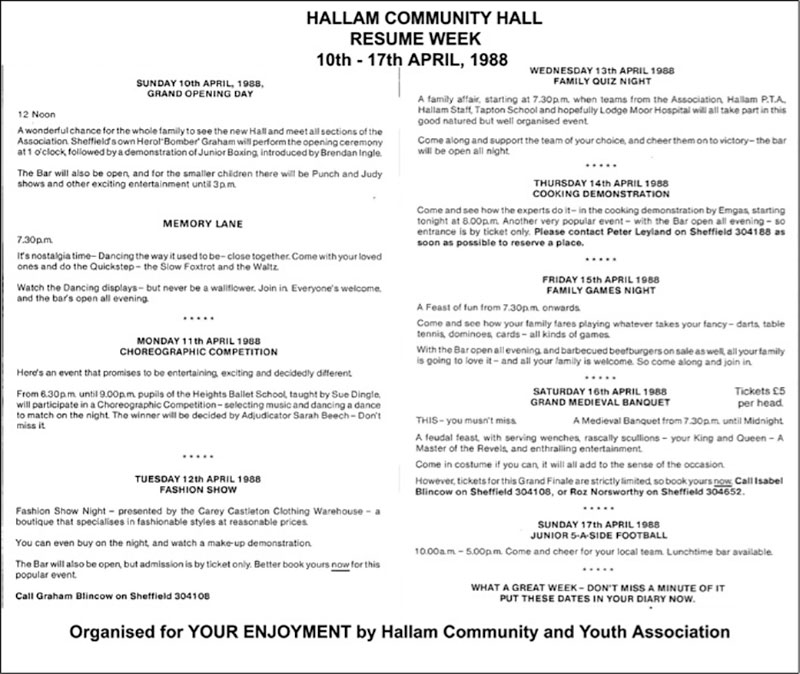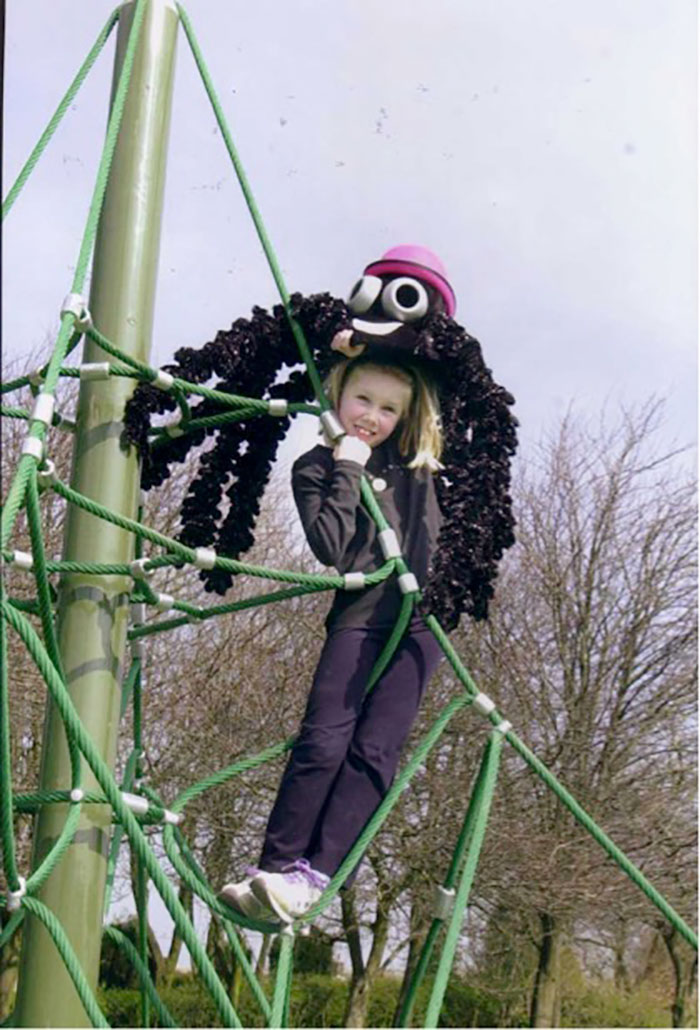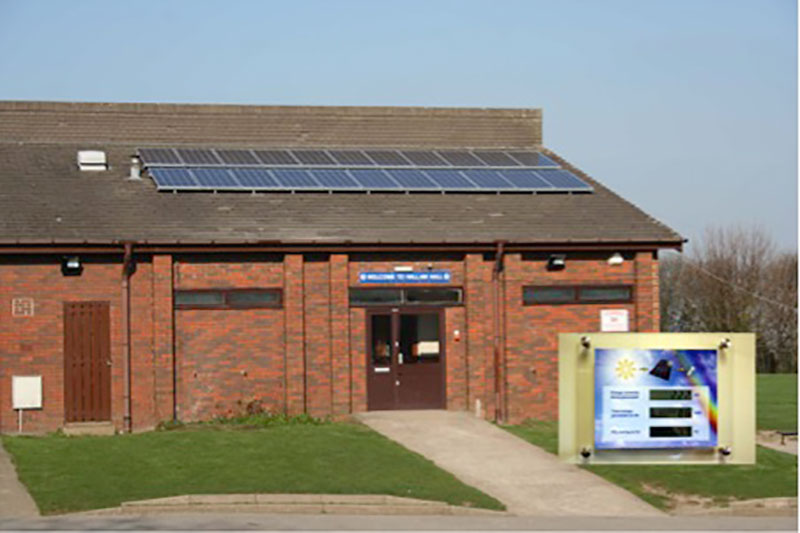Hallam Community and Youth Association
1964-2014
Prologue
Before 1960, except for a few houses on Crimicar Lane, the land between Redmires Road, Blackbrook Road and Crimicar Lane was open land and still being farmed. The same was true of land on the East side of Crimicar Lane. Hallamshire Road was only about 100 yards long, with less than a dozen houses on it Barncliffe Road was the same, and Barncliffe Crescent went only as far as Barncliffe Drive. Hallam Grange Road, Rise and Crescent had only a few houses on them, with large gaps in between small clumps of houses. Hallam Fields Farm stood on land where St Albans Drive is now, surrounded by meadowland.
The Fulwood bus (now the 120 route), had its terminus half way up Crimicar Lane, where Hallamshire Road now starts. The Lodge Moor bus turned round at Lodge Moor Hospital, unless it was one of the few each day which ran all the way to Wyming Brook. The land between those two bus services was largely farmland, but planning permission was granted to build houses, and an extremely large building project was under way.
The Old Fever Hospital at the top of Crimicar Lane had been closed, and it was eventually demolished to make way for a Council-built estate and The Shiny Sheff pub.
In the late 1950s and the early 1960s, therefore, many new houses were built in the area known as Upper Fulwood and Lodge Moor, and a new community was born “The Hallam Village” and the people living there were mostly young families, wanting to socialise and to get to know each other.
The Birth of HCYA
Late in 1964, a group of local people got together with the aim of providing social and recreational activities for the new community. They called their organisation Hallam Community and Youth Association.
The first activity they organised was a Youth Club, held on Friday evenings at Hallam School. This quickly became very popular with the families newly moved into the area, and was soon having to restrict membership, numbers were so high. Other activities were added at varying times over the following years.
The Association’s first formal Constitution was adopted on 2nd May, 1966. It was duly registered by the Charities Commission as Registered Charity No. 523702 on 12th July, 1966.
The Community comes together
Blackbrook Road Playing Field was already designated as public open space, and the field adjoining it fronting on to Crimicar Lane, was owned and operated as a Sports Field by the YMCA. With all the building work going on around it, the YMCA saw an opportunity to “cash in” on the building boom, and published its intention to apply for planning permission to build houses on the Sports Field.
By this time most of the new houses that had recently been built were occupied, and news of the intended planning application spread quickly. As described above Hallam Community and Youth Association was already providing opportunities for the new residents to get to know each other, and to enjoy social events together, but the news of the forthcoming planning application motivated a large increase in membership of the Association so that strong opposition to the application could be organised. The founders recruited many of the new residents to the foundling organisation by knocking on doors, explaining the objectives, and collecting 2/6d (today’s equivalent is twelve and a halfpence) each month, so providing necessary working capital. Their efforts met with tremendous support, and very quickly more than 400 families had been recruited into membership. The object of the Association was simply expressed –
To preserve open space for recreation and to provide cultural and social activities for the residents of Fulwood and Lodge Moor.
Early in 1965 the Association held its first public meeting in the Pavilion on the (then) YMCA Playing Field on Crimicar Lane. HCYA (along with other members of the local community) were keen to retain that space as open land, it being a corridor as it were, to the Blackbrook Road Playing Field and the moors beyond.
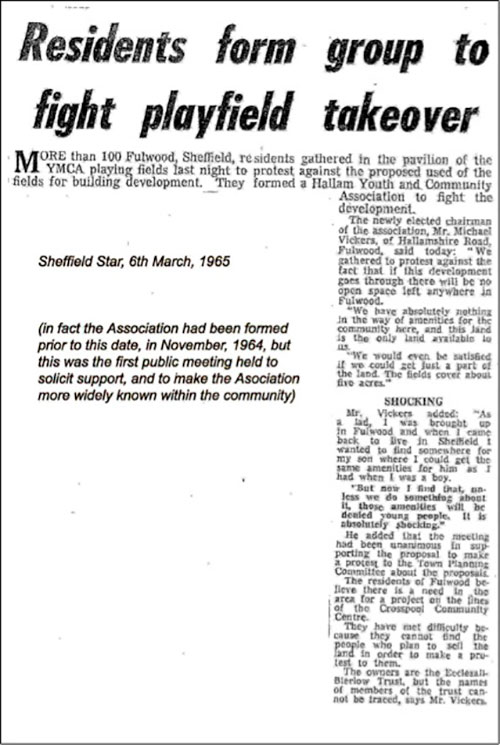
The first formal application for planning permission to develop the land for housing was lodged in 1966, and the Association raised fierce objection to it. This resulted in a compromise arrangement, with the YMCA withdrawing the application in return for permission to build on adjacent land which is now Crimicar Avenue, and undertaking to retain the remainder as private open space. Following this undertaking, the YMCA raised enough finance to enable them to buy the freehold from the original owners, the Ecclesall Brierlow Trust.
During the late 1960s HCYA and YMCA had a constructive and amicable relationship, but on 4th June 1969 local builders Ackroyd and Abbott submitted yet another planning application to build houses on the Sports Field, supported of course by the YMCA. About this time too, YMCA offered to build a community hall on land they owned off Lodge Moor Road if HCYA would withdraw its opposition to the housing development.
The offer was roundly declined!
Sheffield City Council considered the YMCA’s planning application, and the Association was able to provide strong opposition. Planning permission was refused by the Council on 13th October of that same year. The YMCA appealed to the Secretary of State. A Government Inspector was appointed and ordered to adjudicate on the matter, following which the Secretary of State would make his decision. The public enquiry was held in the Town Hall on 9th April 1970, when the Association was represented by specially hired Counsel, Mr. S.S. Gill. HCYA organised a massive demonstration outside Sheffield Town Hall, claiming that there was already a great lack of public open space in the area (much less than was stipulated by statute), and urged the Inspector to refuse the appeal. By doing so they generated much publicity, and they also gave verbal evidence at the public meetings held by the Inspector.
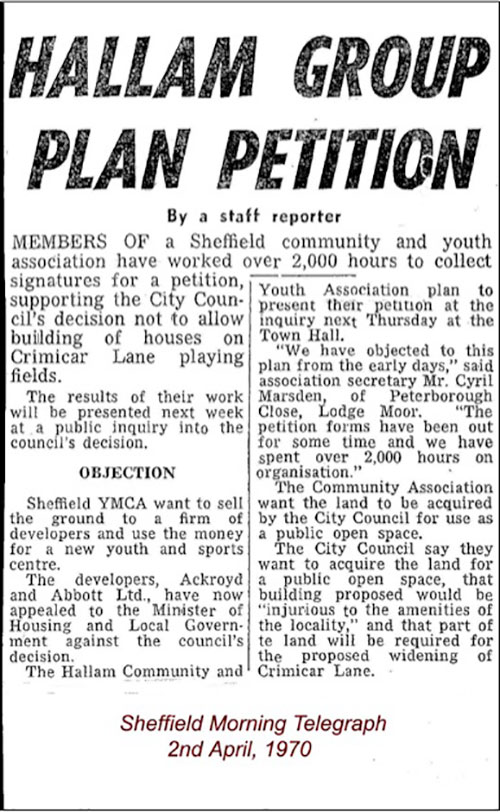
The Association (which by this time had 1,200 members) had also organised a public petition, which solicited a huge positive response from the local community and others, and this too was presented to the Inspector.
In due course (these things take much time) The Inspector, having completed his investigation, went back to Whitehall to compile his report, and it was not until much later that he made his recommendation to refuse planning permission, a decision which the Secretary of State upheld, and the YMCA’s appeal was eventually dismissed on 26th January 1973. The open space that was the YMCA Sports Field on Crimicar Lane remained open space, due largely to the activities of HCYA.
Getting on with other things
However, as previously mentioned, the Association had already started to provide “cultural and social activities” for the local population with the provision of a Youth Club for 9 to 13 year olds, operating in Hallam Middle School every Friday evening. This was very popular, and helpers eagerly came forward to supervise many and varied activities for over 150 children. Other activities quickly followed, and included Badminton (in the School Hall at Hallam School, despite the low ceiling, and later at Tapton School Sports Hall), Ballet (Mondays and Tuesdays in Hallam School West Hall), Choir (Mondays, Hallam School), Swimming (Saturday evenings at Sutherland Road Baths and Upperthorpe Baths (two sessions), Yoga (Hallam School), and Hallam Rangers under-13s Football (Sundays, rear of Sportsman Inn).
At the same time social events were organised, and many of the older members can recall dinner dances, visits to theatres, coach trips and even camping weekends! If someone suggested an activity, every help was provided to make it happen.
Two or three Christmas bonfires were held at The Sportsman Inn on Redmires Road who allowed us to use some of their outbuildings (since demolished) to house a Christmas Crib, and a Father Christmas Grotto, and other stalls and a barbecue were set up outside. The bonfire and firework displays were magnificent – on one notable occasion, the bonfire was so big as to attract the attention of the Fire Brigade from Dronfiel (!), who saw the blaze and thought that Lodge Moor Hospital was on fire. Their appliance duly arrived on Lodge Moor Road, and firemen came running across the fields to tackle the blaze. Although Sheffield Fire Brigade had been forewarned about the event, this apparently did not reach Dronfield!
Also during this time an annual “Hallam Autumn Show” was organised, where the local community were invited to submit entries for the best produce from their allotment and/or garden, children were encouraged to enter their “creations on a given theme”, and cakes and jams were entered and judged.
The Hallam Fete
The first Hallam Fete was held around 1968, and quickly became an annual event on the calendar, with a procession around the area, marching bands, Fete Queen and attendants, decorated floats, The Hallam Majorettes, fancy dress and a varied selection of entertainments in the central arena. Originally the Fete was held on Blackbrook Road Playing Fields, but sometime later was transferred to the Hallam School Playing Field.
Two outstanding entertainments at the Hallam Fete come to mind. One involved three teams of apprentices from engineering companies in Sheffield, who were challenged to pass a piano through an old car tyre hung from a frame. Where three old pianos were obtained is not recorded, but they were duly reduced to pieces small enough to be passed through the tyres. Best recollections suggest that the team from Stanly Tools were the winners. Another memorable event was when a martial arts team from Dinnington came and demonstrated their sport, and also showed how they could lay, naked from the waist up, on a bed of nails, and suffer heavy weights to be placed on their chests. The display culminated when one of their number lay on the bed of nails holding breeze blocks on his chest while the other members of his team smashed the breeze blocks with sledgehammers. Yorkshire Television were there to record the event, and a world record of 100 breeze blocks was secured! Hallam Fete has been held almost every year since that time.
The Hallam Citizen
At the inception of the Association, it was clearly understood that it would be necessary to communicate with the local community on a regular basis, to inform them of activities, and of matters pertinent to the area. In the early years a magazine, modest at first, named “The Hallam Citizen” was produced three or four times each year on an old-fashioned (now) Gestetner machine, and delivered by hand to houses in the area by volunteers. In due course, when membership had increased substantially, it was thought that an annual publication would be sufficient, and this has been the policy ever since.
5,000 copies are produced annually in August/September, and are still distributed by volunteers to each house in the area. It is thought that newcomers to the community find this a valuable source of information, and a considerable number of new members are recruited each year as a result of them reading about our Association in the magazine.
Hallam Community Hall
From the very start of the Association in 1964 it had always been a stated intention eventually to have our own hall, and fund raising to finance this had been a regular feature of the Association’s activities since the beginning. In the early 1970s plans were drawn up and the final drive to raise sufficient funds to build a community hall began. All manner of fund-raising events were organised, and possible grant gaining avenues were explored.
In order to raise further funds more quickly, in 1970 it was proposed to institute a weekly numbers draw, a decision that raised much controversy. At that time, it must be remembered, gambling was not as common as it is these days, there were no betting shops, no National Lottery, and gambling of any sort was considered by many to be a social evil. For some time there was much discussion, and eventually the Association organised a referendum of members to gauge opinion.
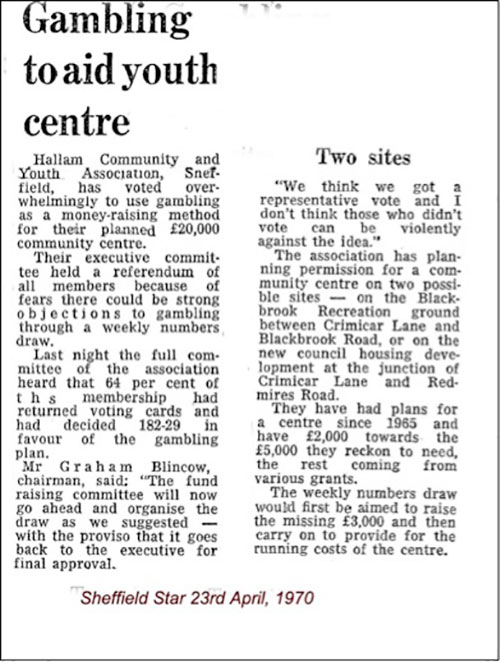
This resulted in a 64% decision in favour, and the motion was duly taken to the Executive Committee for final approval. The records show that a very robust discussion took place, with Committee members either strongly objecting in principle to gambling of any sort, and others in favour of going ahead in order to raise the £3,000 needed as quickly as possible. A vote was eventually taken, which resulted in a dead heat. The Chairman’s casting vote would decide the issue, and although he had originally voted in favour of the motion, he decided to cast the final vote against, so preserving the “status quo”, and ensuring that the Committee was not weakened by threatened resignations. Other, more acceptable ways of raising funds would have to be pursued. And they were! The next three years saw a plethora of coffee mornings and events being organised, and by 1974 the necessary funds had been raised.
Grants of £17,000 from National and Local Government were gratefully accepted, and the Association itself provided the balance of £6,500 to make up the total of £23,500 needed. The building was designed by Harry Edmonson, a member of HCYA and an architect, and would be a single storey, L-shaped building with a flat roof, and would be constructed using pre-fabricated units.
Negotiations with Sheffield City Council resulted in the Association being granted a 28-year lease of a plot of land in the grounds of Hallam Middle School for a rent of £10 per year, and building commenced in the summer of 1974. Imagine the delight of everyone concerned when we actually moved into our own premises later in the year.
The official opening was performed by Sheffield Lord Mayor Councillor Albert Richardson at the Fete in the Summer of 1975, although it had been in use for some months before that.
Formalities completed
It was decided, in September 1974, that the Association had become so large an organisation that it needed a new Constitution. At the same time, because it now owned an asset (the hall) it was necessary to appoint formal Trustees of the Association to execute the Lease and to hold the hall in Trust on behalf of the membership. The New Formal Constitution was formally adopted at a General Meeting of Members, and signed by Peter Leyland, Chairman, and Trustees Mohamed Sami El-Derini, Harry Dean Edmondson, Eileen Ruth Warren, and Graham Blincow were appointed.
Access road
Having built the hall, and brought it into almost constant use, the need to have vehicular access and parking next to the hall was very evident, but there was a problem. We were on school land, and no vehicular access was available. Plans were drawn up to create an access road running to the West of the school buildings, but there was much opposition to this from the school authorities, who thought that this would present a real danger to the children. Negotiations were difficult and prolonged, but eventually permission was given, subject to extremely tight restrictions on when the road could be used. The Hallam Citizen, published in September 1978, contained the following:
“The access road to the Community Hall is now complete and in use. In order to gain planning permission for the road the Executive Committee had to agree to very stringent rules regarding the use of the road. These rules are displayed on the notice board in the Hall, and all Section Leaders have been made aware of them, and they will be brought to the attention of all persons hiring the Hall. Please help us by adhering strictly to them. We must never use the school drive before 5.30 pm on school days. All parking must be on the lay-by on Redmires Road, and if full, on Hallam Grange Crescent, but please do not obstruct driveways.”
The cost of building the access road (almost £2,000), and the locked gate which barred access at the forbidden times, was met entirely by the Association. We are happy to report that, by and large, there were never any major problems with the use of the road, and we continued to have very good relations with the school authorities.
Rapid expansion
With the opening of the hall a host of new activities became possible, and very quickly it was in use almost every day, morning, afternoon and evening.
The Senior Youth Club moved into the hall on Friday evenings in the form of a disco for teenagers, with the Junior Youth Club remaining in the School (a move that allowed them to increase numbers taking part). At its height, there were 350 senior registered members, all with photo ID cards, without which they would not be admitted. With the proceeds of the modest entrance fees, and the profit from the sale of drinks, sweets and snacks it was possible to keep the record collection up to date, buying five or six new discs every week. Disco lighting was soon installed in the hall, and the atmosphere was as good as most other venues offering similar entertainment.
Sadly the Youth Club closed in 1986 due to lack of adult support, and the increasing level of interference by non-members visiting the area bent on disruption. Many members at the time remember “The Hallam” with great fondness.
The Senior Youth Club was re-started in 1990, providing snooker tables, card games, table tennis etc. for children 11-16, but was closed after a few months due to lack of adult support.
Other sections running by this time included the Hallam Chorale, the Wine Guild, the Bridge Club and the Hallam Art Group. Children’s Ballet Classes had been offered at a very early date, and became very popular. A very healthy Family Swimming Group had been created by this time, using various pools at various times, and became strong enough to hold its own Swimming Galas, with a set of trophies to be competed for. A very popular Children’s Playgroup was flourishing, all with mostly voluntary helpers. Hallam Rangers Junior Football Club was well established with three or four teams playing in various Sheffield Boys’ Leagues, and achieving considerable success (Hallam Rangers eventually became an independent Junior Football Club, and is still going strong to this day).
Most of these sections (as they were called) had to limit membership, and had substantial waiting lists of people wanting to join. In addition, it was now possible to organise social functions for the still growing membership, and there are many happy memories of “Saturday Nights at the Hall”.
Ballroom Dancing with Collinson’s Dance Class was also available on Sunday evenings. All these activities (except Collinson’s) were run by unpaid members of the Community Association.
As well as developing its own activities, the Association continued to keep a watching brief on local developments in the local community. When Council plans to develop land between Redmires Road and Tom Lane were announced (to the East of Hallam School), the Association called a public meeting to oppose the plan to build houses, and instead develop recreational facilities and play areas.
Unfortunately, the plans had already gone too far, and houses were eventually built, and even more valuable open space was lost.
As well as using the hall for its own activities, the Association was now being asked if the hall was available to hire for weddings, birthday parties, and other celebrations. It was clear that there was a considerable income stream available, and the Executive Committee decided that they should act to take maximum advantage of this demand. It soon became evident that we needed bigger and better premises, and in 1979 the Community Hall Extension Fund (CHEF) and fund-raising activities were accelerated. At the same time some temporary school classrooms (Terrapins), which had been located on the tarmac in front of the hall, were vacated by the school and permission was obtained to use them as additional accommodation for use by the Community Association. This additional space allowed more activities to be brought on stream.
In 1979 the Tennis Section started, using courts at Tapton School, and a Walking Club was formed, which proved to be an instant success.
By 1980, the CHEF Fund had grown to £3,000, and the declared aim was to increase this to £5,000 before the end of the year. By 1981 the membership had grown to 900 families, and plans to extend the hall were drawn up and passed by the Local Authority. These plans provided for an additional room for activities on the North-West corner of the existing hall, separated from the main hall by folding doors which would give the option of having separate halls or one large open space. The original pre-fabricated structure would be replaced with solid brick walls across the entire Western front of the hall. Some internal modifications were also planned, with the kitchen being relocated and more storage space being created. The whole of the Western frontage would be furnished with a pitched roof to replace the existing flat roof which by now had started to need constant repair.

The hall extension was eventually completed in 1983 at an overall cost of £36,000. Grants totalling £27,000 had been obtained, the CHEF fund contributed £3,000, and a bank overdraft of £6,000 was negotiated (secured by personal guarantees by the four Trustees).
Normal activities had continued almost uninterrupted during the building work, and all the usual Association activities were being offered. The popular Hallam Fete was now one of the major annual events in our area, and served to bring the community together, being organised by the Association but now involving other local organisations including Hallam School, St. Luke’s Church, and many others.
In 1982 a Junior Cricket Section was successfully launched and supervised by members of the Senior Section. Both the Senior and Junior Cricket Sections were flourishing, with impromptu friendly games organised against other like-minded cricketers. We were hampered, however, by the conditions on Hallam School Playing Field, which was badly drained, and sometimes matches had to be called off due to too much water on the wicket. A solution, however, was at hand!
From pre-fab to permanent
Plans were now laid to build brick walls around the whole of the remaining pre-fabricated structure and to replace the flat roof with a pitched roof. As well as paying off the £6,000 loan, fund raising schemes were necessary to provide the funding for this further work. 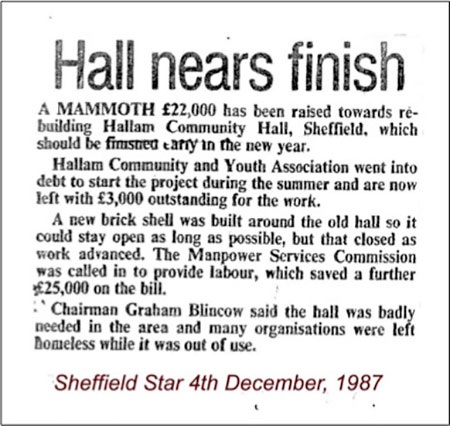 Activity and events in the hall rose to an all-time high, with something taking place almost every week. Membership of the Association was flourishing, and by 1985 both the North West and the North East walls had been built in brick at a total cost of £17,000, and the overdraft had been paid off. The stage was now set for the final work, which would include the building of the remaining wall across the South East of the building, construction of a pitched roof over the main hall, and the removal of the pre-fabricated parts of the building, which would be carried out of the front door! To achieve this goal, more fund-raising was called for, another bank overdraft was organised, and finally, in 1988, Hallam Community Hall would be fully refurbished.
Activity and events in the hall rose to an all-time high, with something taking place almost every week. Membership of the Association was flourishing, and by 1985 both the North West and the North East walls had been built in brick at a total cost of £17,000, and the overdraft had been paid off. The stage was now set for the final work, which would include the building of the remaining wall across the South East of the building, construction of a pitched roof over the main hall, and the removal of the pre-fabricated parts of the building, which would be carried out of the front door! To achieve this goal, more fund-raising was called for, another bank overdraft was organised, and finally, in 1988, Hallam Community Hall would be fully refurbished.
Work started in May 1987, with the Manpower Services organisation Volserve providing the labour. This was to be a double-edged sword – whilst the labour was free, and all we had to pay for were the materials, the workforce was made up of trainee apprentice bricklayers supervised by a professional builder. Progress was slow, and the completion date was revised a number of times. Nevertheless, we were making progress, and the Hall would be completed in due course.
During this period, of course, the Association were unable to use the hall, but saying “the show must go on” prevailed, and other venues were sought. Fortunately, the school was available for hire, and many of the usual activities were held there. Monthly Executive Meetings were held at “The Three Merry Lads” pub, and a fund-raising Halloween dance was held at the “Norfolk Arms”, Ringinglow. Problems had been experienced in raising a bank overdraft facility, which was eventually resolved by changing our account to NatWest, and the Trustees (John Longmire, David Swann and Graham Blincow) giving personal guarantees to secure the loan. By 31st March 1988 the overdraft had risen to £16,794.
During this difficult period a small sub-committee had been working to devise ways of attracting local people to the grand reopening (called by them “Resume Week”). The actual opening date was fixed for 12 noon on Sunday 10th April 1988, and the well-known Sheffield boxer Herol “Bomber” Graham agreed to come along and perform the opening ceremony. A full, week-long programme of events was put in place, and details were hand-delivered by members to every house in the area.
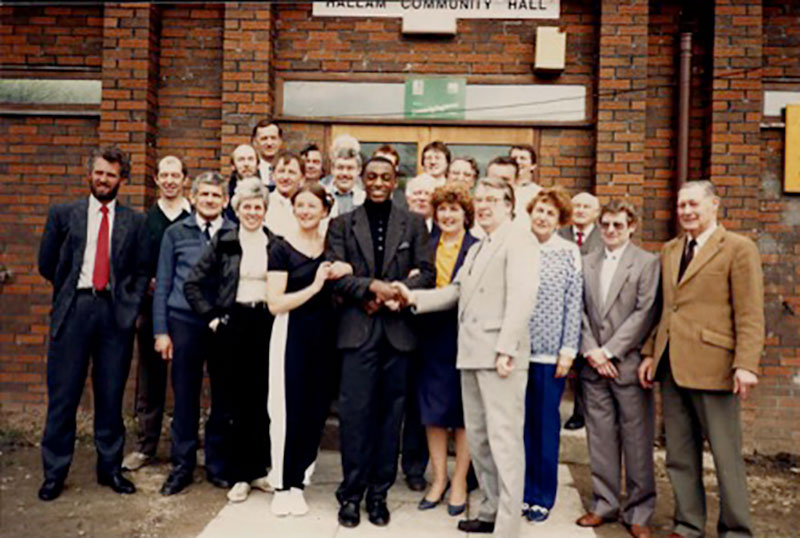
Herol “Bomber” Graham and friends at the official reopening 10th April 1988
Resume Week was a great success, with many members and non-members attending the varied activities. A considerable number of new members were recruited.
By the end of the financial year at 31st August 1988, the bank overdraft stood at £15,716. Again, fund-raising activities were organised by nearly all the sections and the very hard-working Social Committee, and by the end of the following year it had been reduced to £7,105. A year later, at 31st August 1990 it was £98, and the Association had a positive cash flow. The Trustees were thanked for their support in guaranteeing the overdraft, and they in turn thanked all concerned for the hard work that had gone into eliminating the debt.
However, it must be recorded here that although fund-raising was hard work, it gave birth to many, many happy and joyful events, where members and non-members alike enjoyed a vast range of events. The community, indeed, worked well together!
Late in 1988 the Walking/Rambling Section was started with organised walks on Sundays, and although attendance was initially somewhat sparse, numbers gradually grew over the next few years until a group of almost 50 members emerged. In 1990 two weekend visits to the Lake District were a great success.
25 years old already!
Commencing on 1st September, 1989, the Association celebrated its Silver Jubilee, and a week-long programme of events was organised from Saturday 23rd September until Sunday 1st October, which was enjoyed by over 2,000 people from the local community, whether they be members of the Association or not.
Hallam Community and Youth Association
Silver Jubilee Celebrations
25 years of living and socialising together!
Open to all members of our Community
Saturday 23rd – 60s Night, dancing to a big band, both ballroom and pop. Includes cold buffet supper, and bar.
Sunday 24th 12 noon – Open House Silver Jubilee Celebration. The whole community is invited to come and help celebrate, with all sections displaying their activities and new members being recruited. Cheese and wine will be provided, as well as a cash bar.
Monday 25th – Cookery demonstration by Yorkshire Electricity Board. A full house to enjoy an informative evening.
Tuesday 26th – Family Games Night, including table tennis, darts, bridge, whist crib, etc. Snack food will be provided, along with the cash bar.
Wednesday 27th – Quiz Night. Four teams from the local area competing for the honour of being Silver Jubilee champions. Coffee and cakes provided, cash bar.
Thursday 28th – Monte Carlo Night. Everyone is invited to come and try their prowess at roulette, black jack, escalado etc, using Monopoly money. Continental food for supper. Bar.
Friday 29th – Teenage Fancy Dress Party Disco. The hall will be jam packed full for a wonderful party night.
Saturday 30th – Old Time Music Hall. Many classic music hall acts supervised by a Master of Ceremonies. Supper will be pies and peas, bread and dripping, and black pudding. Cash bar.
Sunday 1st October 3pm – Children’s Party, with entertainers and party games, fancy hats and buns and cakes for eats.
Further progress
In 1990 the Senior Youth Club was restarted with an emphasis on table games, and in 1991 the newly formed Drama Group put on its first pantomime, “Cinderella”, which was highly acclaimed by all who attended the performances, and was very much enjoyed by all who took part. In that year, also, the Gardening Section was formed, which allowed interested parties to work together to obtain substantial discounts on purchases of equipment and plants, seeds, etc. Sadly, in 1992 the Senior Youth Club closed for the last time due to lack of support, both from adult helpers and teenagers, who were now becoming more interested in electronic devices.
The minutes of an Executive Meeting held in December 1992 reported that the Association had a membership of 373 families, had positive cash resources of £8,330, and that the following sections were functioning: Bridge, Junior Football (at various times between three and five teams), Badminton, Ballet, Cricket, Yoga, Gardening, Playgroup, Chorale, Art Group, Wine Guild, Rambling, Ladies’ Keep Fit, Men’s Keep Fit, Swimming, Tennis, Indoor Bowls, Country Dancing, and Drama. A craft fair held in late November had produced a profit of £750.
Early in 1993 the membership had risen to 483 families, and a Mountain Biking Section was being formed. A Diary of Social Events organised for the whole year was produced by the Social Committee and 5,000 copies had been printed. 3,000 copies were to be delivered locally, and 2,000 would be delivered through sections.
A very memorable social function was held on Saturday 22nd May, 1993, when a “Blitz Night” (featuring a group entitled “The War Babies”) attracted 150 people and produced a profit for the Association in excess of £500.
Birkdale School field (again)
In 1995, the Association submitted an objection to another application by Birkdale School, the owners of the playing field on Crimicar Lane, for planning permission to build houses on the land. Sheffield Council confirmed to the Association their policy of retaining the land concerned as Green Belt land, and therefore planning permission would be refused. The Association reaffirmed to Birkdale School that any application to the Secretary of State to overrule the Council’s decision would meet with massive opposition, and that fierce lobbying would ensue. An offer to purchase the land from Birkdale, and make the field available as open space for use by the local community, was refused. Birkdale decided NOT to further their application.
Further expansion
During the early 1990s there had been much talk about the possibility of further extending the hall to provide changing rooms, further storage, and another meeting room, and by December 1994 it was reported that the Local Authority had at last signified their agreement to such a development. A new lease was to be prepared to make provision for this, and at the same time it was proposed to extend the period of the lease for a further period of time. At an Executive Meeting held in February 1995, draft plans were agreed with a costing of £75,000, and it was decided to make an application to the new National Lottery for a Grant to assist with the cost. The Lottery had not long been in existence, and it was decided to “strike whilst the iron was hot”, as not many grants had yet been agreed. Members were both surprised and delighted to learn that a grant of £43,700 had been approved, and appeals to many other grant making charities, both locally and throughout the country produced a further £15,100. The remainder of the money would have to be found from the Association’s own resources, and in order to provide necessary working capital during the building work a further overdraft of £28,000 was negotiated with the bank, again being personally guaranteed by the Trustees, who at this time were Alan Bone, Graham Lyon and Graham Blincow.

The new lease was eventually prepared and signed, lasting for 40 years at an annual ground rent of £1,000. An architect and quantity surveyor were recruited from our own membership, and following advertising for tenders to be submitted, local builders T. & C. Williams were awarded the contract. Building work started on Friday 12th January 1996, and with very few hitches the new building was completed in early June, 1996. A Grand Opening Ceremony was planned for Sunday 8th September, and individual invitations were sent out to all 560 members.
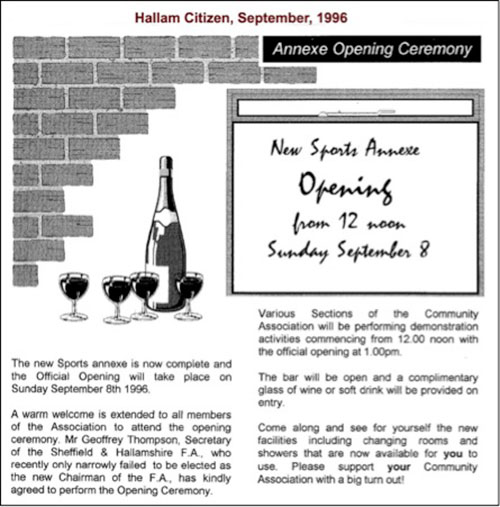
The ceremony attracted many visitors, and the opportunity was taken to introduce newcomers to the existence and workings of the Community Association. On Wednesday 11th September, the Heritage Minister, Lord Inglewood, visited the Community Hall to see for himself the use to which the Lottery Grant had been put. He was entertained by demonstrations of dancing, by Sue Dingle’s Dancing Class, and Football. Lawrie Madden, erstwhile Sheffield Wednesday footballer and member of the Association, was on hand to put the footballers through their paces. At last, the dancers and footballers, and others, had the long awaited changing rooms that they deserved, and a training room in which they could receive instruction. The bank overdraft facility had been most useful during the building work, providing essential working capital to iron out timing differences between receiving payments of the grants and builder’s stage payments, but the Association did not need a permanent overdraft, and in the accounts for the year ending 31st August, 1996 showed a positive bank balance of £819, a most pleasing result. By the same date in 1997, the Association had replenished its cash resources, and the bank balance was £5,551.
Involvement in local matters
During the ensuing three years, the Association was considerably involved in three local developments which impacted on the community at large.
The first was when Birkdale School applied for permission to divert the footpath running through the middle of their sports field on Crimicar Lane. A public local enquiry was held on 15th July 1997, and the Association made representations to the effect that if permission were granted then Birkdale should be asked to create a substantial new path to the North end of their field which would facilitate prams, bikes and wheelchairs to enable access to the Blackbrook Road Playing Field on the West side of the sports field. The Inspector subsequently reported later in the year, when permission to move the footpath was granted on the condition that it was wheelchair-friendly, and fenced off from the sports field. Result!

At this time Birkdale School was not using the field at all, the grass had grown into a wild meadow, and there seemed to be no plans in place for a future use. Once more, the Association wrote to Birkdale School, offering to purchase the field, and make it available in perpetuity for use by the local community. The offer was not taken up.
The second development was the resiting of “The Barncliffe Stoop”. A local resident had drawn up plans to copy the old milestone and waymarker that is held in the Sheffield Museum, and place it in the position it held for many years, on the Long Causeway which is now mainly Redmires Road and beyond leading into Derbyshire. In due course plans were approved for this project, and Hallam Community and Youth Association were pleased, when asked, to help finance the work. You can now view the Barncliffe Stoop across the road facing Hallam Grange Rise, and there is also a small information board to explain the history of this local landmark. The Association was pleased to be able to help this small, but important, local project.

The third project was in association with The Lodge Moor Local History and Conservation Group, who were concerned over the future of Wyming Brook, a local area of great natural beauty. The Group were campaigning for the road through this valley to be downgraded to prohibit motor vehicles using it, as this had in the last few years resulted in much fly-tipping in the beauty spot. The Community Association shared the anxiety expressed by the Group, and were able to help with essential funding to drive the project forward. On 5th July 1999 the appropriate Traffic Regulation Order was passed by Sheffield Council, and plans to install barriers to bar access to motor vehicles down the valley were eventually implemented. All concerned were relieved that the sanctity of this very-much loved beauty spot was now assured. If you’ve never been there, take a trip. It’s worth it!
Millennium
In 1997 it was decided that it would be fitting to define a project to celebrate the forthcoming Millennium, and invitations were issued to the local community to attend a public meeting to discuss ways in which this might be achieved. After considering a number of suggestions, it was finally agreed to adopt the revival of Spider Park, a Council-run childrens’ play park situated on the Blackbrook Road Playing Field as our project.
Spider Park
The first children’s playground was erected in the mid-1960s, and consisted of swings, a roundabout, a slide, a rocking horse and a climbing frame. Because the climbing frame was in the form of a large spider, the local children quickly started to refer to the playground as Spider Park. The name stuck. Over the years the equipment wore out, and, because of financial constraints, was removed but not replaced. It was a day for great sadness when the old spider was finally cut down, leaving only the swings and the slide.
A small sub-committee was formed, and work on planning the new park got underway. Much consultation took place within the local community, including St. Luke’s Pre-School Nursery, Hallam Playgroup, Local Brownie and Scout groups, and Hallam Junior and Infant School. Much of the consultation was in the form of a special referendum of pupils on the items of equipment that the children would want. A special logo was designed, and a children’s competition to name the spider resulted in “Webster” taking centre stage. Small lapel pins were produced and sold for £1 each in the local shops, and very soon almost everyone was wearing a Webster pin! A consultation letter was sent to all parents at Hallam School, which elicited 171 positive, supporting responses.
Three playground contractors were asked to submit plans and quotes, and one was selected after rigorous consultation.
An Application for Funding was submitted to the Community Fund (National Lottery Charities Board) and after an anxious wait, in 2001 a grant of £137,000 was announced, to the great delight of all concerned.
The Association leased the area of land from Sheffield City Council for a term of 15 years and undertook to act as caretakers of the site. Sheffield City Council undertook to provide maintenance and insurance services.
Although the playground itself was funded by the grant from the Community Fund, Hallam Community and Youth Association commissioned and paid for a wrought iron archway to welcome everyone to the playground. They also produced a small plaque to be displayed on the site, giving the history of Spider Park. There is also a time capsule containing items and letters collected at the Millennium New Year’s Eve Party, buried beneath the spider.
On Thursday, 23rd March 2002 Spider Park was officially opened by the Chairman of Hallam Community and Youth Association, Mr. Alan Bone. Over 100 children and their families were in attendance, and the Millennium dream was achieved at last! Job done!
The winds of change
In 2002 a new section, The Thursday Walking Group, started operations, and quickly became very popular. It met fortnightly on Thursdays at 10.30 am and went on easy-going 3 to 4 mile walks mostly in the Peak District. This section quickly grew in size, and is now known as The Walkie-Talkies, and operates weekly, with some “away days” being contemplated. It’s a very sociable group, and anyone can join. This group does not replace the Rambling Section, which continues meeting monthly on Sundays and normally covers some 8 to 10 miles. Something for everyone!
As time goes by, things grow, mature, and sometimes move on. During 2003 the Hallam Playgroup found it impossible to continue with the voluntary helpers who had run the group for many years. Such groups now came under the watchful eye of Ofsted, and government legislation required at least 50% of the staff to be professionally qualified. This was not something that our volunteer helpers could undertake, and sadly, on 22nd July the Playgroup closed. Some time later a Pre-School organisation offered their services on a professional basis, and it was agreed that they would hire the hall, and provide a service. This they did, with our blessing and benevolent hiring rates, for just a few months after which they declared the enterprise commercially not viable, and to our great disappointment, closed down.
Similarly, the Dance and Gymnastics Section ceased to operate as a section of the Association, run by volunteers, but was taken forward by private individuals who hired the hall and ran classes on a business footing. Although the Association lost members (and their subscriptions) it was able to replace this revenue with hire fees.
Moving with the changing times, in 2003 the Community Association set up its own website, giving information about the Association similar to that featured in “The Hallam Citizen” It was updated again in 2013, and can be viewed at www.hcya.co.uk
Mention has already been made of Hallam Rangers Junior Football Club, and how it started out and functioned for many years as a section of the Association, run by enthusiastic volunteers. It’s very pleasing to note that it is still going strong as a separate entity, and that it owes its origins to HCYA.
In a similar way, Hallam Choral Society ran for many years as a very successful section of the Association until, in 2010 its members decided to form themselves into a separate charitable organisation called The Hallam Chorale, which they decided was a better way forward. They continue to hire the hall each Monday, and remain close to the Association.
Birkdale School playing field (yet again!)
In Autumn 2005 Birkdale School applied for permission to convert the old “pavilion” into stables for horses, with the object, it was thought, of letting the land for grazing by horses. The Association objected to this plan, insisting that the land should be retained as a sports field, and expressing fears that this could be a way of eventually securing planning permission for housing on the site. Letters were sent to all the residents living adjacent to the field informing them of the plans, and inviting them to lodge objections. The Association itself made strong representations to the planning authority against the idea, and enlisted the support of Local Councillors and the Local Member of Parliament. Many other objections were lodged by individuals. This strong feeling against the scheme caused the project to be quietly abandoned.
Fun Day Spoiled
Fun Day in 2006 was planned to be held on Saturday 8th July, and all the preparations for fancy dress, dancing displays, silver band, and everything else that goes towards making this annual event a really good community celebration were in place. However, on Friday, the day before Fun Day, the Association was told that a local resident had complained that we were not properly licensed to hold an event of this kind, and it would have to be cancelled. Despite frantic efforts to confirm or refute this accusation in time, 3pm Friday arrived and all the school children had to be told of the cancellation before they left school. There were many tears. More so, when at 4.30pm, we eventually clarified that we were properly licensed! What a shame that the actions of one individual, who could not see beyond his or her selfish concern for a tranquil afternoon deprived hundreds of local residents and children of a real community “feel good” event. Fortunately the Association has never experienced this kind of bitterness either before or since, and it is sincerely hoped that nothing like it will ever happen again.

The following year, 2007, the Association was determined that Fun Day would be reinstated and once more be regarded as THE local community annual celebration. And so it proved!
Crimicar Lane playing field (for the last time?)
During 2009 the Association was delighted to hear that Hallam Cricket Club had taken a 40-year lease of the playing field on Crimicar Lane from the owners, Birkdale School. Fears of continuing efforts to obtain planning permission to build on the land faded away, and everyone looks forward to enjoying the open aspect of the area across Crimicar Lane towards Spider Park with great satisfaction. Things may change in 40 years time, but that’s one for the future! The Association was pleased to facilitate meetings with the community and Hallam Cricket Club, and gives every support to the efforts being made to develop the sports ground into a top class facility.
Going green to reduce our carbon footprint
Early in 2010 two grants were obtained to enable the installation of photovoltaic panels on the roof of Hallam Community Hall. Cavity wall Insulation and additional loft insulation finished the job of making us much more energy-efficient. The electricity generated by the panels immediately reduced fuel bills, and the Feed-In Tariff allows us to claim payments for the electricity generated, especially when surplus power is fed into the National Grid. We also contribute to the effort to reduce our overall carbon footprint. A genuine win win situation, as they say!
The school field, and the fence
Also during 2010 Hallam School informed the Association that they intended to apply for planning permission to erect a two metre high fence around the whole of the school property, including the whole of the field to the North of the school. This, they said, would provide much improved security for the campus, as well as making the school property less prone to mindless recreational vandalism which typically occurred at night and over weekends. The Association was able to give its support for a fence, but sought discussions with the school regarding the area to be enclosed. At the same time many local residents were very concerned that the field, which was used as a public recreational area, would no longer be available as such, and mounted a very vocal opposition to the plan. The Association and the protest group were not entirely agreed on the way to proceed – we preferred quiet diplomacy as opposed to their megaphone diplomacy, and each continued with their separate negotiations with the school authorities. The Association also had concerns regarding the reduction in the amount of car parking space, and the fear that parking would spill over on to surrounding public roads. During the next few months, and continuing into the following year, much animated discussion took place between all concerned, and, it must be said, some antagonism was created. The Association had suggested that only part of the field should be within the fence, and argued that compromise was the way forward. The matter was at such a delicate point in the Summer of 2011 that it was sadly decided that the annual Fun Day could not be held. The protest group had lodged an application for the field to be designated as a village green, and feelings on both sides were running high. At the Sheffield Council Planning Committee meeting both groups made separate representations opposing the school’s plans to enclose the entire field, and a majority of Councillors on the Committee adjourned the meeting to give the parties an opportunity of reaching a compromise. In the end, the school decided that they would erect a fence only 1.4 metres high, which did not need planning consent, and thankfully they agreed to enclose only the area of field that was needed for school purposes. At last, the matter was resolved by their unilateral action, and no-one could prevent it happening, although the village green application remains undecided for the time being.
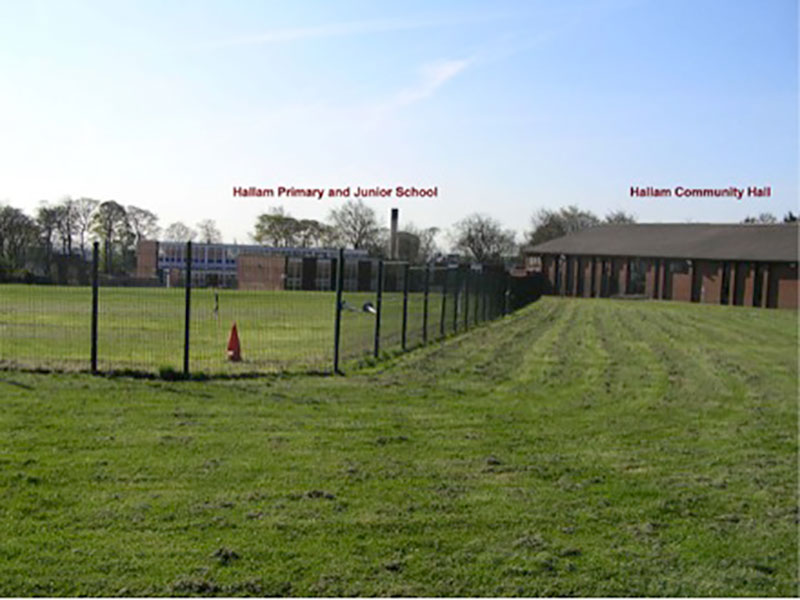
The end of family subscriptions
Since its inception, the Association has always maintained that it wanted to encourage family membership, and accordingly the annual subscription had been framed to reflect that, by offering one rate for the whole family to enjoy membership. This system was perfect in times gone by, but things change and in 2012, after much internal debate and soul-seeking, it was recognised that this was no longer appropriate for the majority of members. At the Annual General Meeting in November 2012, it was agreed that a flat rate individual membership fee should be adopted, and that this would come into force at the beginning of the financial year on 1st September 2013. The rate of the fee, as always, will be set from time to time by a vote at the Annual General Meeting.
Epilogue
After 50 years of “community service”, the Association is rightly proud of its role in the lives of those living in the local community, “The Hallam Village” and who have enjoyed some part of the activities organised by those who have chosen to volunteer their help. Help can mean many things, from being Minutes Secretary for meetings, to providing assistance at the annual Fete, to helping to make tea for an evening event. Many of our helpers have been doing it for a long time, and are “getting near their ‘sell-by’ date”. It is tragic to think that there might be no-one to follow on.
In compiling this brief history, it was tempting to list names of people who have, now and in the past, given of their time to the Association. In the end, this temptation was resisted purely because it was certain that someone’s name would be missed out, and that would have been an insult. Suffice to say that anyone and everyone who has played some small part has our heartfelt thanks for a job well done. There are very few community organisations who are not part funded by Local Authority support, and although we have had our share of available grants through the years, we have never needed to rely on outside help for our continued operation. We are a healthy organisation with a good management, and we need to make sure that we continue to be so.
The Association still has much to offer and much more to achieve, and to do this it needs new blood to bring in new ideas, to cope with new technology, and to revitalise its operations to make sure it continues to operate successfully for the next 50 years. Most of the Council members are now over 60 years old, and new, younger volunteers are needed to guide the Association in the future. Being involved does not have to rule one’s life, and even two hours per month to attend the monthly Executive Council Meetings would be an enormous help. We need new volunteers. We are positive that there are those out there in our community who would willingly lend their services – all we have to do is to identify them. The best way of making that happen is to contact us through the contact details on our website.
www.hcya.co.uk
Those who come forward and offer to help will never regret it – as well as the camaraderie involved there is a tremendous amount of enjoyment to be gained by being part of a well organised and forward looking organisation, doing everything they can to help their neighbours and nearby friends live together in peace and harmony, regardless of background, race, religion or political viewpoint.
That’s what it is, and always has been, all about!
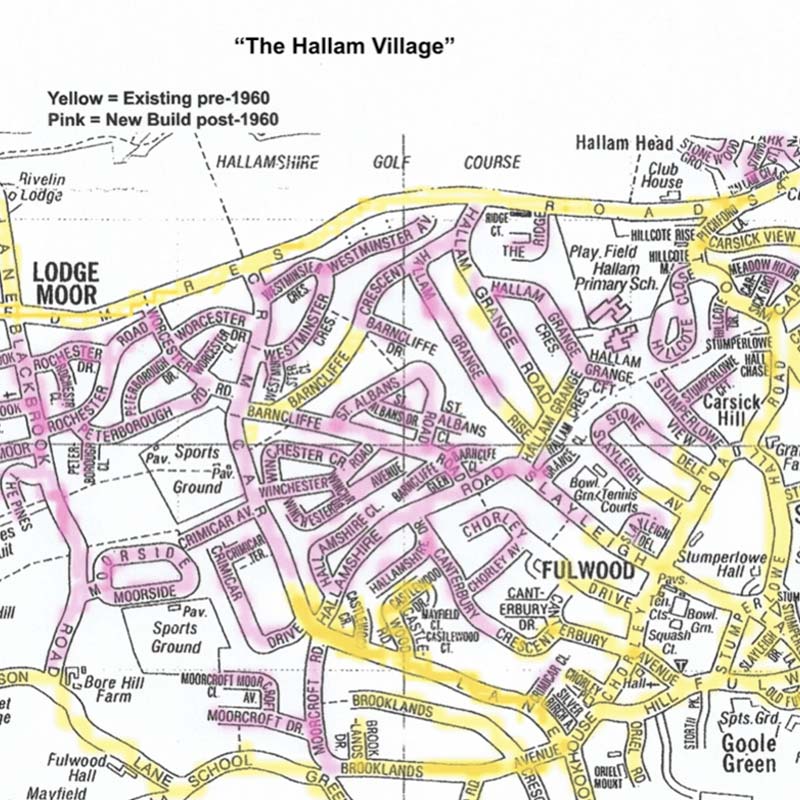


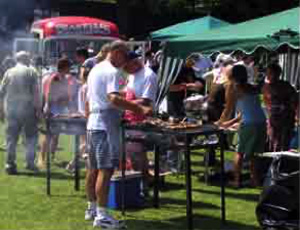
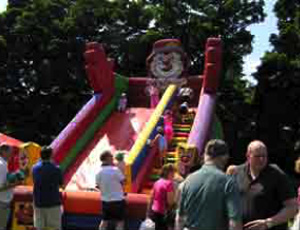


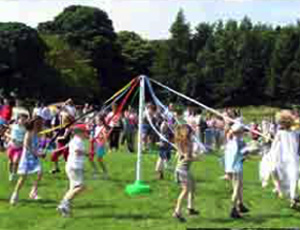
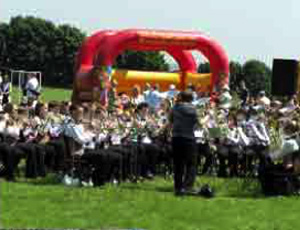

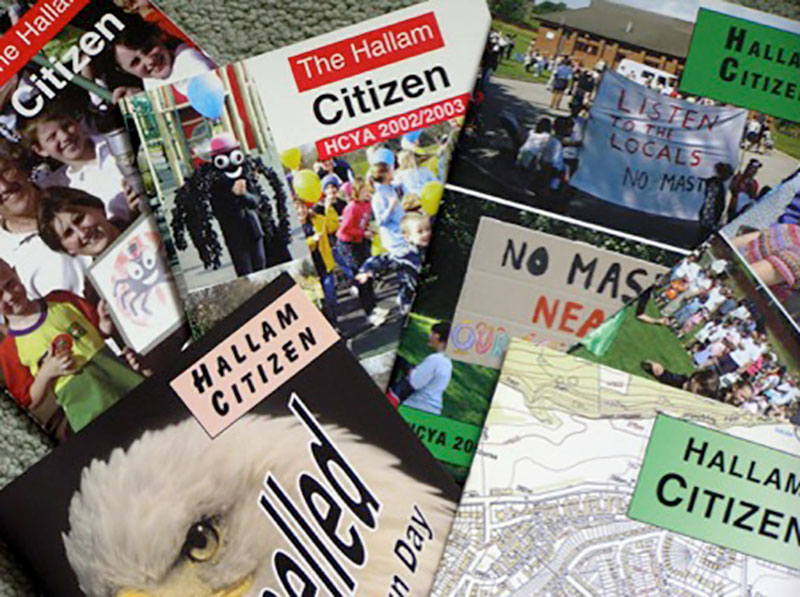


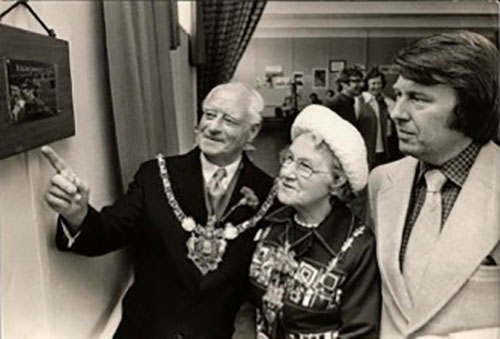

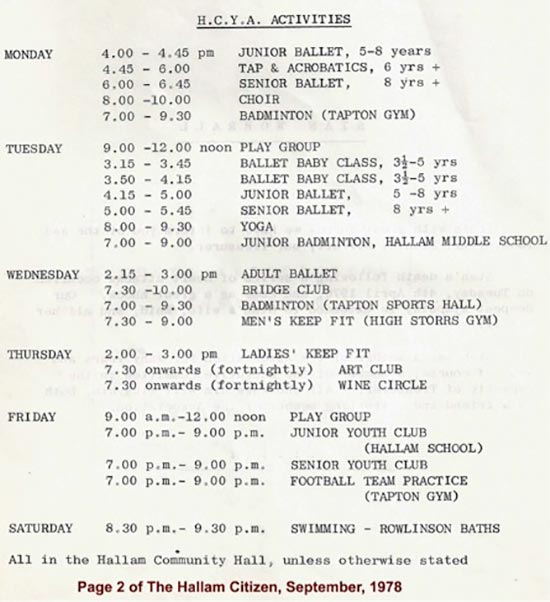
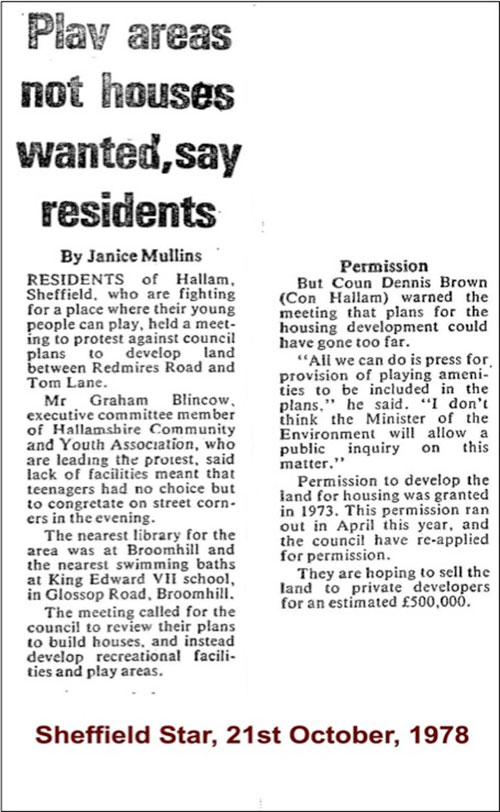
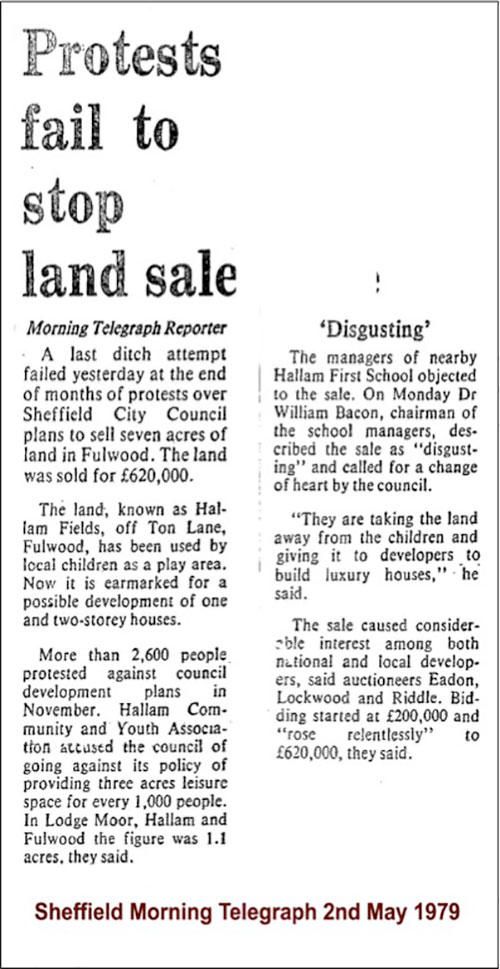

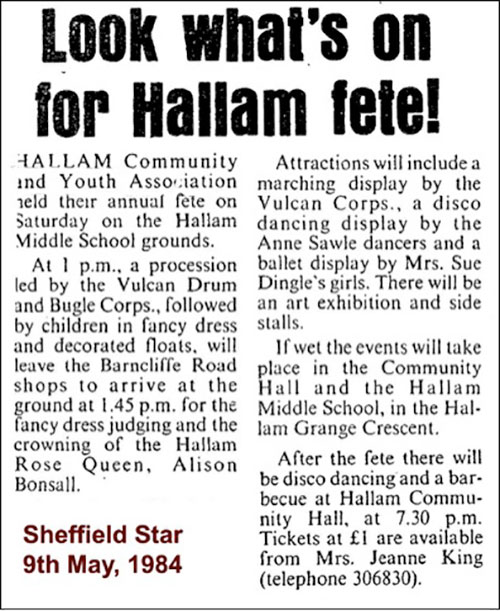

 Activity and events in the hall rose to an all-time high, with something taking place almost every week. Membership of the Association was flourishing, and by 1985 both the North West and the North East walls had been built in brick at a total cost of £17,000, and the overdraft had been paid off. The stage was now set for the final work, which would include the building of the remaining wall across the South East of the building, construction of a pitched roof over the main hall, and the removal of the pre-fabricated parts of the building, which would be carried out of the front door! To achieve this goal, more fund-raising was called for, another bank overdraft was organised, and finally, in 1988, Hallam Community Hall would be fully refurbished.
Activity and events in the hall rose to an all-time high, with something taking place almost every week. Membership of the Association was flourishing, and by 1985 both the North West and the North East walls had been built in brick at a total cost of £17,000, and the overdraft had been paid off. The stage was now set for the final work, which would include the building of the remaining wall across the South East of the building, construction of a pitched roof over the main hall, and the removal of the pre-fabricated parts of the building, which would be carried out of the front door! To achieve this goal, more fund-raising was called for, another bank overdraft was organised, and finally, in 1988, Hallam Community Hall would be fully refurbished. 


